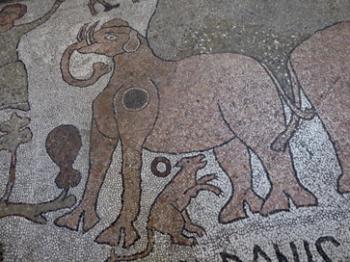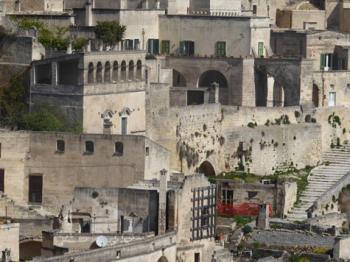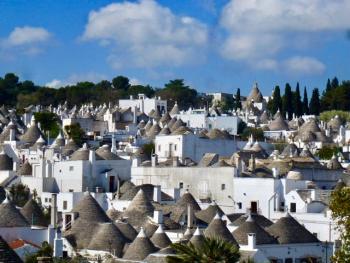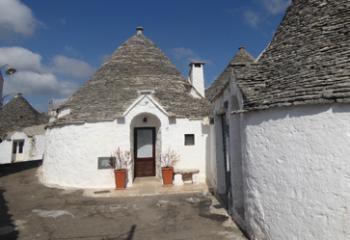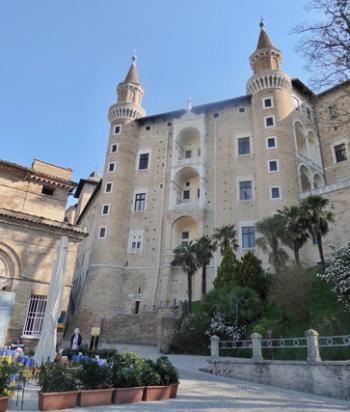‘Undiscovered Adriatic’ with GCCL
This item appears on page 26 of the June 2018 issue.
If you enjoy walking through walled old towns, seeing snowcapped mountains and miles and miles of olive trees and visiting UNESCO World Heritage Sites that are not crowded with travelers, head to the bottom of the “boot” in Italy.
“Undiscovered Adriatic: Eastern Italy, Venice, Puglia & Malta” was the title of the small-ship cruise around that area that my husband, Thom, and I took with Grand Circle Cruise Line, or GCCL (Boston, MA; 800/221-2610, www.gct.com). It was the inaugural journey of that cruise.
Our ship, the 50-passenger M/V Artemis, sailed out of Venice on March 19, 2017, then continued south around the “boot” of Italy and west to Malta, where we debarked on April 4.
The price for this cruise varies by month and deck. Not including airfare, our price, minus our frequent-Grand Circle-traveler credits, was $4,795 per person in a main-deck double cabin.
Lunches eaten off the ship were sometimes not included, but fabulous agriturismo lunches were included in the price, as were the wine, beer and soft drinks served before and during dinner.
I considered the fare to be very inclusive; all but one excursion (the one to Matera) was included, along with the city walks (one in each port), a ferry to the Tremiti islands and a bus to Urbino and other sites. We always docked in the main port, within walking distance of town.
After a couple of days in Venice, the cruise reintroduced us to Ravenna’s stunning 4th- to 6th-century Byzantine mosaics, found in eight World Heritage Site churches and baptistries; Dante, whose mausoleum is in Ravenna, termed them a “symphony of color.”
Our next port call allowed us to visit the fifth-smallest independent country in the world, which is also the world’s oldest republic and oldest sovereign state: San Marino. The medieval walled Old City of San Marino crowns a mountain, while the busy modern city lies below. Its UNESCO-listed buildings can be seen on an up-and-down walk on winding, pedestrian-only streets.
At our next stop, we traveled by bus to the World Heritage Site of Urbino, where the Ducal Palace was impressive both for its architecture and its Renaissance art collection. During the Renaissance, Urbino attracted noted scholars, architects and artists; Raphael was born there. The city is still an important center of education with a vibrant university atmosphere.
The Tremiti Islands, a short ferry ride from Puglia’s north coast, have only a small population in the winter, but in warm weather they host large numbers of Italian tourists who enjoy the cliffs and sandy coves, the boating and the old churches. The weather was comfortable during our visit to two of the islands.
The World Heritage Site of Alberobello is known for its trulli. With their round drystone construction and conical roofs, they looked like Hobbit houses.
Once used to store grain or as stables or single-family dwellings, trulli were first documented in 1704 and continued to be constructed into the 20th century, gradually becoming deserted in the last half of the 1900s.
Closely packed in two areas of the town, many are now refurbished summer homes or tourist lodgings. Some are shops, and there are churches with trulli roofs. We visited one such house, invited inside by the residents.
The sassi of Matera, another World Heritage Site, are ancient cave dwellings and freestanding structures sculpted out of soft stone in a deep valley. Some of the dwellings date to around 7,000 BC.
The sassi were once the heart of peasant life, with people and animals living in very poor and unhealthy conditions until the 1950s, when the government relocated them. The dwellings, approximately 1,000 in number, were almost forgotten by the world until 1990, when they were recognized by UNESCO and restoration began.
The varied and multifaceted buildings — architecture carved from the rock — provide a beautiful view from above of quarries, ravines, cave churches and fortifications.
At the heel of the boot of Italy, we discovered the charming old town of Otranto, which has been ruled by a long list of conquerors. A town of Greek origin, it became a Roman city, then Norman and then part of the Principality of Taranto. It was captured by the Ottoman Empire in 1480, but the Turks were defeated by a combination of Crusaders. The Turks recaptured it but were again repulsed from the city and from the rest of Apulia. Napoleon took the city in 1804.
Our stroll of the walled Old City revealed many traces of these invaders, including the 15th-century Castello Aragonese and the Otranto Cathedral, with a mosaic pavement laid in 1163-1165. Winding, pedestrian-only streets now offer shops and restaurants.
Our Grand Circle cruise ended in Malta, which has its own collection of World Heritage Sites, but that’s another story.
MARGO WILSON
Scottsdale, AZ

